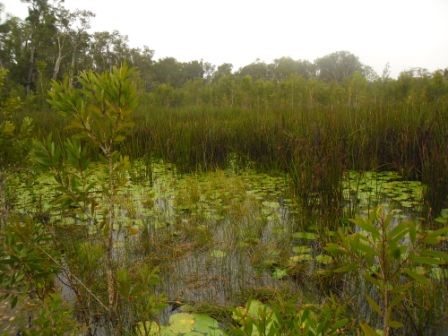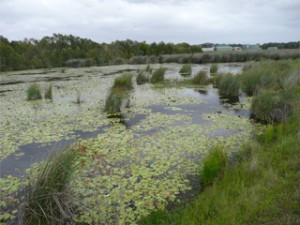Constructed Wetland Treatment Systems
Constructed wetlands are engineered ecosystems designed to treat wastewater including sewage, stormwater and agricultural runoff. Wetland water treatment systems use plants and naturally occurring microorganisms to reduce nutrients, pathogens and sediments which are present is wastewaters. Constructed wetlands can treat wastewater to a high level, and they have a number of advantages which may include lower construction and operation costs, and environmental and aesthetic benefits.
Ecoteam specialises in design, construction and maintenance of wetland water treatment systems, and our wetland designers collectively have more than four decades of experience in wetland research, design, construction, planting and maintenance.
Wastewater Wetlands
Constructed wetlands are often used as a component of municipal sewage treatment plants, especially downstream effluent “polishing” and reuse, such as the 15ha polishing wetlands and the 24ha effluent reuse wetlands at Byron Bay Sewage Treatment Plant. Constructed wetlands are commonly used to treat sewage in rural and remote locations where there is no centralised sewerage system. Constructed wetlands can often be used as an eco-friendly alternative to aerated water treatment systems (AWTS) which use a lot of electricity and have higher maintenance requirements. Ecoteam normally uses paperbark trees in sewage treatment wetlands due to their enhanced treatment capability, ease of maintenance and aesthetic appeal. Ecoteam staff have designed and/or installed sewage treatment wetlands for houses, wastewater treatment plants, villages, retreats, schools, and even an orang-utan sanctuary in Borneo.
Stormwater Wetlands
Constructed wetlands can effectively detain and treat stormwater, and they are increasingly used in housing estates, highway developments, and industrial sites. Ecoteam wetland designers are experienced at stormwater wetland design. Key projects by Ecoteam staff include:
Brisbane airport stockpile wetlands. Design of a series of integrated WSUD treatment devices consisting of swales, mini-wetlands and treatment wetlands to detain and treat runoff from 1.5km of mulch stockpiles for the Brisbane Airport Runway Project.
Corindi Beach Stormwater Wetlands –– Design / construction supervision of a stormwater treatment wetland for a 50-lot subdivision with multiple inlets, macrophyte zones and melaleuca gravel beds, designed to protect a sensitive downstream environment
Malabugilmah Stormwater Wetlands.- Design / construction of a stormwater treatment wetland for an Aboriginal Village consisting of three treatment stages
Benefits of Constructed Wetlands
Well designed constructed wetlands will effectively treat wastewater, however they have a number of advantages compared with other treatment systems, and can provide a number of important ancillary benefits:
Less operation and maintenance – Wetlands often have lower maintenance requirements and are cheaper to operate than other treatment systems. Small-scale wetlands can generally be maintained by system owners, in contrast with other treatment systems such as aerated water treatment systems, which require regular electrical and plumbing maintenance.
Smaller carbon footprint – Wetlands can be entirely gravity-operated, and they do not require energy-intensive pumps and blowers. This translates to lower operating costs.
Habitat – wetlands provide habitat for a wide range of native animals, and even small wetlands can become important bird nesting sites.
Landscaping – wetlands have aesthetic appeal, and are often located to maximise their landscaping value.
Melaleuca Wetland Plants
Paperbark (Melaleuca) trees are very well suited to constructed wetland environments. The soft, papery bark layers of paperbark trees is around 90% air space, and it extends to their finest roots. This air-filled matrix allows paperbark trees to “breathe” when their roots are submerged, but it also leaks a lot of oxygen to the substrate. As oxygen is an essential component of wastewater treatment, this increases their ability to clean water. Natural paperbark wetlands are exceptionally productive, and support a diverse range of native fauna and flora. Natural paperbark wetlands play an important role by cleaning and priming water before it reaches rivers or underground aquifers. However, a number of paperbark ecosystems are being seriously impacted by development, with destruction of more than 95% of Melaleuca quinquenervia wetlands in S.E. Queensland and NSW. Construction of large-scale paperbark wetlands can add significant ecological value to an area, and the Byron Bay Effluent Reuse Wetland – a 24ha constructed paperbark wetland with around 500,000 trees – is a prime example.






